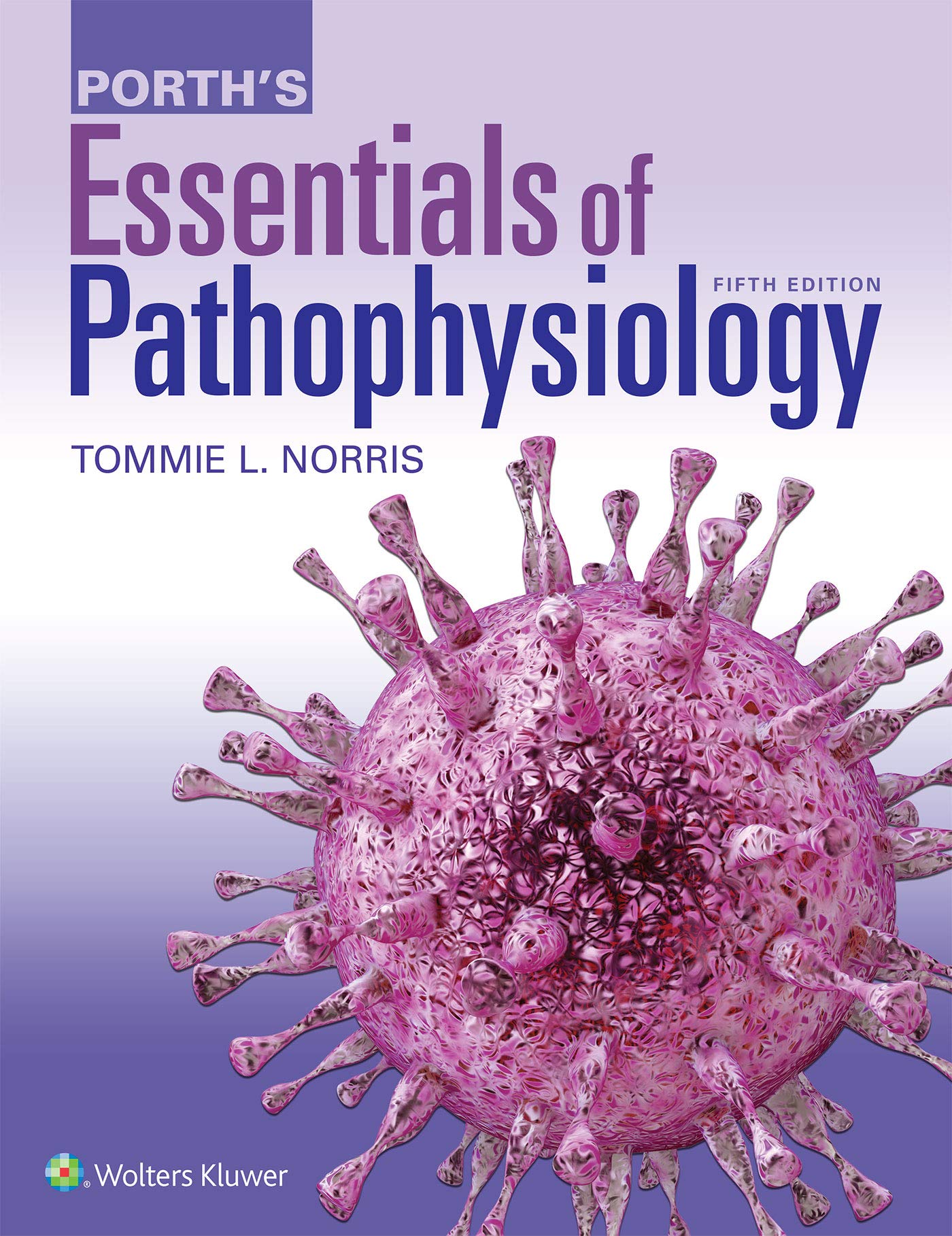Porth’s Essentials of Pathophysiology 5th Edition Test bank
Digital item No Waiting Time Instant DownloadChapters: 28Format: PDFISBN-13: 978-1975107192ISBN-10: 1975107195Authors: Tommie L NorrisPublisher: LWW
In Stock
Original price was: $55.00.$24.00Current price is: $24.00.
Porth’s Essentials of Pathophysiology 5th Edition Test bank
Test Bank for Porth’s Essentials of Pathophysiology, 5th Edition
The Test Bank for “Porth’s Essentials of Pathophysiology, 5th Edition” is a comprehensive study resource designed to support nursing and healthcare students, educators, and professionals in mastering the key concepts of pathophysiology. This test bank provides an extensive collection of practice questions, complete with detailed answers and explanations, aligned with the textbook’s content.
Overview
Purpose and Use
- Comprehensive Review: Offers a thorough review of pathophysiology concepts, including disease mechanisms and their effects on the body.
- Exam Preparation: Assists students in preparing for exams, quizzes, and certification tests related to pathophysiology.
- Concept Reinforcement: Helps reinforce understanding of complex pathophysiological processes and their clinical implications.
Question Types
- Multiple-Choice Questions: The primary format, with questions designed to assess a range of pathophysiology topics, including disease processes, symptoms, and treatment options.
- True/False Questions: Evaluate the accuracy of statements related to pathophysiological concepts and clinical scenarios.
- Fill-in-the-Blank Questions: Test knowledge of specific terms, definitions, and concepts related to pathophysiology.
- Short-Answer Questions: Require detailed responses and explanations of pathophysiological processes, case studies, and clinical applications.
- Matching Questions: Match terms with their definitions or concepts with their descriptions.
Answer Rationales
- Detailed Explanations: Each question includes a detailed rationale explaining the correct answer and the reasoning behind it.
- Conceptual Understanding: Provides context to enhance comprehension of pathophysiological mechanisms and their implications.
Key Features
Comprehensive and High-Yield Content
- Key Topics Covered: Includes critical topics such as cellular injury, inflammation, immune responses, genetic disorders, and pathophysiology of major organ systems.
- Current Information: Reflects the latest research, guidelines, and best practices in pathophysiology.
Clear and Concise Format
- Organized Structure: Questions and answers are presented in a clear and logical format for effective study and review.
- Visual Aids: May include charts, diagrams, and tables to illustrate complex pathophysiological processes and concepts.
Interactive and Engaging
- Active Learning: Practice questions encourage active recall and application of pathophysiological knowledge.
- Study Tools: Flashcards, quizzes, and mnemonics may be included to reinforce key concepts.
Key Topics Covered
Cellular Pathophysiology
- Cell Injury and Death: Mechanisms of cellular injury, including hypoxia, ischemia, and toxic insults, and their effects on cellular function and survival.
- Inflammation and Repair: Processes of inflammation, including acute and chronic inflammation, and the body’s response to tissue injury and repair.
Genetic and Developmental Disorders
- Genetic Mechanisms: Understanding of genetic mutations, inheritance patterns, and the role of genetics in disease development.
- Developmental Disorders: Pathophysiology of congenital and developmental disorders, including their impact on organ systems and overall health.
Immunity and Immune Disorders
- Immune Response: Mechanisms of the immune response, including innate and adaptive immunity, and their role in protecting against disease.
- Immune Disorders: Pathophysiology of autoimmune diseases, hypersensitivity reactions, and immunodeficiencies.
Major Organ Systems
- Cardiovascular System: Pathophysiology of cardiovascular diseases, including hypertension, atherosclerosis, and heart failure.
- Respiratory System: Mechanisms of respiratory disorders, such as asthma, chronic obstructive pulmonary disease (COPD), and pneumonia.
- Renal System: Pathophysiology of renal diseases, including acute kidney injury, chronic kidney disease, and electrolyte imbalances.
- Gastrointestinal System: Understanding of gastrointestinal disorders, such as peptic ulcer disease, inflammatory bowel disease, and liver diseases.
Endocrine and Metabolic Disorders
- Endocrine Disorders: Pathophysiology of endocrine disorders, including diabetes mellitus, thyroid disorders, and adrenal insufficiency.
- Metabolic Disorders: Understanding of metabolic disorders, such as obesity, dyslipidemia, and metabolic syndrome.
Neurobiology and Neurological Disorders
- Neurobiology: Mechanisms of neurological function and dysfunction, including neurotransmission and neural plasticity.
- Neurological Disorders: Pathophysiology of neurological diseases, such as stroke, neurodegenerative disorders, and seizures.
Benefits of the Guide
For Students and Practitioners
Focused Learning
- High-yield questions and rationales help concentrate on critical aspects of pathophysiology.
- Detailed explanations and visual aids enhance understanding and retention of complex concepts.
Efficiency and Convenience
- Organized format allows for efficient study sessions and effective use of time.
- Portable notes and questions enable flexible study options, allowing review anytime and anywhere.
Confidence Building
- Practice questions and detailed rationales build confidence and reduce exam anxiety.
- Comprehensive preparation ensures readiness for exams and practical application in clinical settings.
For Educators
Supplemental Teaching Tools
- Test bank questions can complement lectures and course materials, enhancing the learning experience.
- Use of questions and rationales in classroom activities and assessments supports student learning.
Assessment and Feedback
- Practice questions help assess students’ understanding and progress.
- Detailed rationales provide constructive feedback for improvement.
Practical Applications
Self-Study and Review
- Use the test bank for focused self-study sessions to reinforce pathophysiological concepts and prepare for exams.
- Quick review sessions with concise questions and rationales to consolidate learning.
Group Study Sessions
- Collaborate with peers using practice questions and rationales for interactive learning.
- Use the test bank during group discussions and study sessions to enhance understanding.
Exam Preparation
- Thorough preparation with comprehensive practice questions and detailed explanations.
- Practice with realistic questions to ensure readiness for exams and practical assessments.
Conclusion
The “Test Bank for Porth’s Essentials of Pathophysiology, 5th Edition” is an essential resource for nursing and healthcare students and professionals seeking to excel in understanding pathophysiology. With its comprehensive coverage, detailed rationales, and effective study strategies, this test bank provides a thorough approach to mastering the principles and applications of pathophysiology. Whether used for self-study, group activities, or exam preparation, these resources support individuals in achieving success in their educational and professional pursuits in pathophysiology.


Reviews
There are no reviews yet.